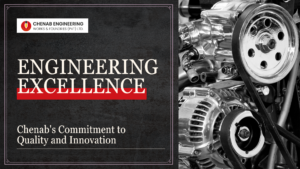In an era where precision and efficiency are paramount, advancements in mold design have become the cornerstone of high-quality casting.
Sand casting procedures have been greatly enhanced by developments in mold and core manufacturing techniques, allowing foundries to manufacture complicated and high-quality castings more accurately and efficiently. These developments tackle issues like surface polish, mold complexity, and dimensional precision.
Mold design has undergone a significant transformation, driven by the relentless pursuit of perfection in the foundry industry. At Chenab Engineering Works, we understand the essence of innovative mold design for impeccable casting quality production.
In other words, let us focus on how progress in mold design has contributed to improving casting quality and what part Chenab Engineering is playing in bringing this revolution.
The Evolution of Mold Design
Mold design has transformed, moving away from traditional approaches towards state-of-the-art tools. In the past, creating molds required a lot of manual labor and relied heavily on skilled artists. The foundry industry started incorporating more advanced techniques with the growing need for greater precision and superior material qualities.
3D Printing for Patterns and Cores
With its ability to revolutionize mold and core production, 3D printing, a type of additive manufacturing, is gaining recognition in the sand casting industry. The use of 3D printing allows for the quick manufacturing of intricate cores and complex patterns, resulting in shorter tooling lead times and faster prototyping.
Computer-Aided Design (CAD) and Simulation:
The use of simulation software and computer-aided design (CAD) has been one of the biggest innovations in mold design. These tools let engineers develop extremely accurate and detailed molds that can be virtually tested before being produced.
Foundries can digitally create molds and examine the flow of molten metal during casting thanks to modern computer-aided design (CAD) and simulation tools. This enhances casting quality by optimizing gating systems and mold designs.
Sustainability in Mold Design
As people become more environmentally conscious, the significance of sustainability in mold design has significantly grown. Just like other sectors, waste reduction and mitigating environmental effects are gaining importance in the foundry industry.
Eco-Friendly Mold Design Methods
- Recyclable Materials: Mold-making with recyclable materials contributes to waste reduction and resource conservation.
- Energy-Efficient Procedures: By using energy-efficient mold-making procedures, the foundry industry’s carbon footprint is decreased.
- Waste Reduction: By utilizing cutting-edge design and simulation technologies, material waste in production is minimized through optimized mold designs
Material Advancements in Mold Making
There have also been significant improvements in the materials used to make molds. New materials that are more durable and effective are being used in place of conventional mold materials like metal and wood.
Important Material Developments
- High-Temperature Alloys: By withstanding the high temperatures required for metal casting, these alloys help to prolong the life of molds.
- Molds made of ceramic: In the foundry business, ceramic molds are becoming more and more common because of their exceptional precision and thermal durability.
- Composite Materials: By fusing the finest qualities of several materials, these materials offer increased flexibility and strength.
At Chenab Engineering, we are always looking into new materials to see how we can enhance our mold designs and guarantee the best castings possible.
Conclusion
The foundry industry has changed significantly as a result of improvements in mold design, which have made it possible to produce castings of higher quality more precisely and efficiently. At Chenab Engineering Works, we take great pride in leading the way in these advancements and using cutting-edge materials and technology to provide our clients with outstanding products.
To guarantee the highest quality and performance, we incorporate innovative materials, temperature control, automation, 3D printing, CAD and simulation, and sustainability into our mold designs. Chenab Engineering is dedicated to pushing the frontiers of innovation and providing value to our clients as the foundry industry develops further.





